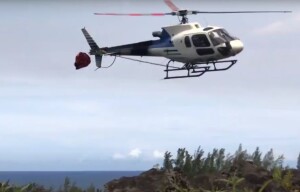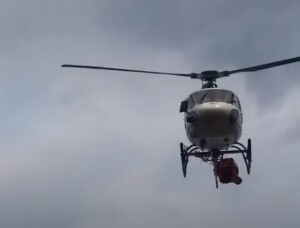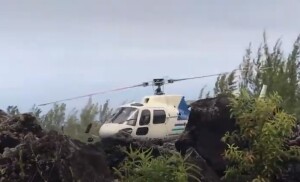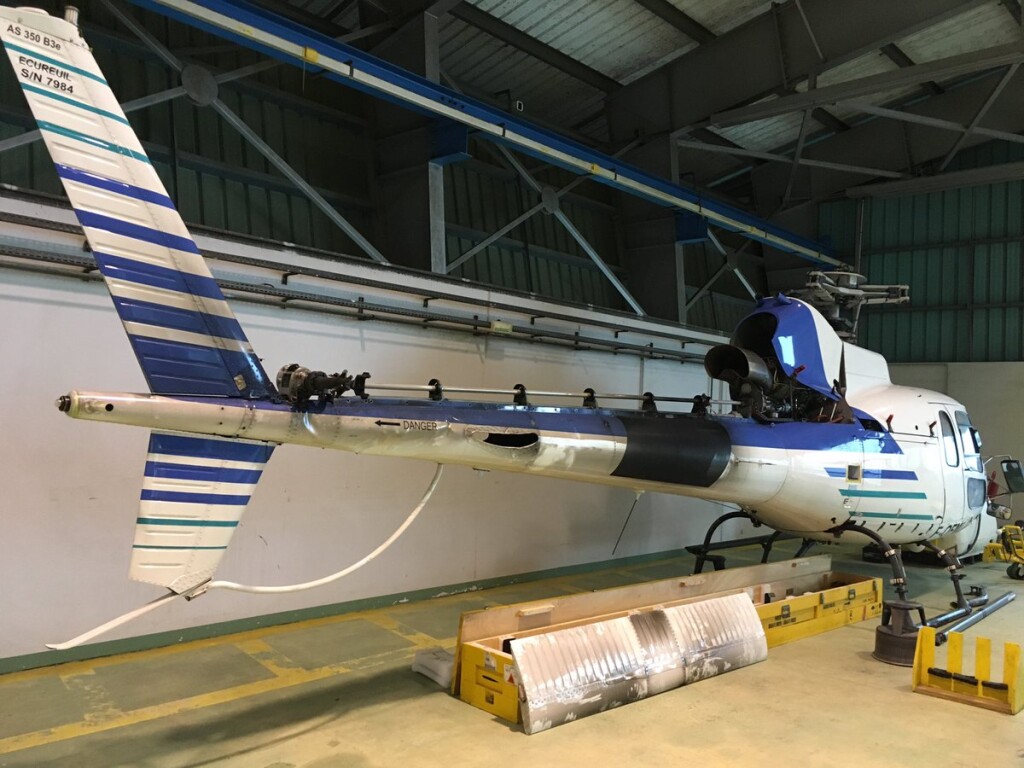Short Sling Stings Speedy Squirrel: Tail Rotor Strike Fire-Fighting in Réunion (Hélilagon Airbus AS350B3e / H125 F-OFML) with Video
On 24 January 2019 Airbus Helicopters AS350B3e (H125) Squirrel F-OFML of Hélilagon suffered a tail rotor failure during fire-fighting with an underslung bucket at Grand-Brûlé, Sainte-Roseon on the Indian Ocean island of Réunion.

Hélilagon Airbus AS350B3e / H125 Trailing its Tangled Bambi Bucket after an Impact with its Tail Rotor while HESLO Fire-Fighting at the Piton de la Fournaise Volcano, Réunion (Credit: YouTube Video Posted by BK117)
The French Bureau d’Enquêtes et d’Analyses pour la Sécurité de l’Aviation Civile (the BEA) explain in their safety investigation report (issued only in French) that the pilot (who had 10,129 hours of flying experience and 4,198 on type) had been flying for four days fighting fires on the eastern side of the Piton de la Fournaise volcano. This was by both by direct water drop and replenishing temporary reservoirs set up by ground fire-fighters using pumps and hoses.
The helicopter had an underslung 820 litre Type 1821 Bambi Bucket on a short 5 m sling (so the bottom of the bucket was c 9.7 m below the helicopter in the hover) to do both tasks.
Having dropped water on the main front of the fire at 2,200 ft AMSL (location 2 the graphic below), the helicopter was returning to collect more water from a point about 2 nm away, on the lower slopes of the volcano at 385 ft AMSL (location 1 below). Wind was north-easterly, gusting 30 knots.

Route of Hélilagon Airbus AS350B3e / H125 while HESLO Fire-Fighting at the Piton de la Fournaise Volcano, Réunion (Credit: BEA)
During that leg while descending through at 930 ft AMSL at 13:48:17 (location 3), the pilot heard a high-frequency noise at the same time as feeling a slight jerk to the left. The pilot then perceived a loss of effectiveness of the rudder pedals. After a MAYDAY call, the pilot continued flying with the intention of finding a suitable area for an emergency landing.

Hélilagon Airbus AS350B3e / H125 Trailing its Tangled Bambi Bucket after an Impact with its Tail Rotor while HESLO Fire-Fighting at the Piton de la Fournaise Volcano, Réunion (Credit: YouTube Video Posted by ‘BK117B2’)
This part of the flight was captured on the early part of the VIDEO.
The pilot was not able to find a location suitable for a run on landing. When airspeed was reduced, the helicopter started to rotate around its yaw axis and made two and a half turns before a hard landing at 13:52:45 (in location 4 at 315 ft AMSL) on a lava flow from 2002, near the coast road.

Hélilagon Airbus AS350B3e / H125 Yawing Anti-Clockwise: <1s after the Previous Image (Credit: YouTube Video Posted by ‘BK1172’)
The helicopter was shutdown. On egress the pilot discovered the cables of the fire-fighting bucket were entangled with the tail rotor and the tail rotor blades were broken at 3/4 length. The right skid was broken in several places and there was impact damage from the underslung load on the tailboom. A local news report contained close-up images.
Closer examination revealed that the Tail Gear Box (TGB) casing had fractured around its circumference. The BEA determined this was due to overload when the blades struck the underslung load.
The BEA observe that flight and wind parameters derived from the two independent onboard recording systems (an Appareo Vision 1000 and a Helisafe system) “show that the helicopter was operating in a very turbulent air mass”. This is likely due to be a combination of the wind and the Volcano topology, supplemented by heat from the fire.

Vision 1000 and Helisafe Data Recorded Onboard Hélilagon Airbus AS350B3e / H125 while operating near the Piton de la Fournaise Volcano, Réunion (Credit: BEA)
When the underslung load hit the tail rotor the helicopter was flying at an indicated speed of 97 kt, with a rate of descent of 1,230 ft/min in a “particularly turbulent environment”.
The BEA note that the manufacturer’s manual for the fire-fighting bucket can only be complied with if the bucket is connected directly to the cargo hook (with no sling) or by using a sling of at least 15 m. The manual also states airspeed with the bucket fitted should not exceed 80 kt and recommends that when approaching that airspeed, caution is exercised. Airbus has issued several documents to warn of the risks when operating with external loads including Service Letter No 1727-25-05 of 26 March 2006 and Safety Information Note (SIN) No 3170-S-00 of 3 October 2017. Following this accident, SIN No 3349-S-25, specific to the use of the fire-fighting buckets was published in June 2019 and emphasises the importance of adhering to the associated limitations. Airbus’ safety database shows no similar incidents involving longer slings and such buckets.
The operator, which had conducted fire-fighting in Réunion for over 30 years and maintained two helicopters on permanent stand-by, had however always used 5 m slings. Their procedures stated that slings over 8 m were “not recommended” and the short slings were preferred due to what they stated were “greater precision and ease of use by the pilot in hovering flight.” However, the BEA identified that another operator in Réunion used 15 m slings, as evident in the video screenshot of another aircraft in the vicinity of the accident helicopter, and so did SAF, the operator’s parent company (who had acquired Hélilagon in 2016), when firefighting in the French Alps.

The Accident Helicopter (foreground) and an AS350 of Another Company (background) with Longer Sling (Credit: YouTube Video Posted by ‘BK117B2’)
The operator switched to 15 m slings immediately after the accident. Additionally, the BEA comment that while the pilots recent duty and flight time was within legal limits…
Helicopter firefighting activity requires pilots to have high concentration, repetitive actions, precision work when loading and delivering water, flying close to the ground…[and]…the intensity of the firefighting work may have been a physiologically trying change of pace upon returning from a three-week holiday period.
BEA Conclusions
The underslung fire fighting-bucket damaged the tail rotor. The collision was due to a combination of factors:
- Use of a sling shorter than recommended by the manufacturer. This increased the risk of a collision.
- Flight above the maximum airspeed for the bucket.
- Very turbulent air.
- A descending trajectory where the helicopter momentarily descended faster than the empty underslung, but trailing load.
Our Observations
This accident is a reminder that just because an organisation has done something one way for a generation, their written procedures may be neither safe nor compliant. The operator deserves credit however for immediately changing the sling length used “next day”.
The aircraft was well instrumented with Vision 1000 and Helisafe, considering it is of a size where data recorders are not required by regulation. It’s not stated by BEA whether the operator conducted any Flight Data Monitoring (FDM). If they did, that would bring considerable safety benefit and provide a way to monitor airspeed during fire-fighting, turbulence and usage generally, providing positive feedback to crews.
After a loss of tail rotor drive, the airflow over the vertical stabiliser provides some directional stability hence the desire for a run on landing if such a problem is suspected. While not commented on by the BEA, the trailing bucket may have delayed the loss of yaw control until the point the aircraft was much slower, and helped minimise the impact. UK CAA research on Helicopter Tail Rotor Failures (CAA Paper 2003/1) included a study of mitigations that included deployable devices, such as an inflatable fin and drag (or drogue) parachute.

UK CAA Research Published in 2003 Considered a Drag Chute as a Deployable Mitigation to Tail Rotor Failures (Credit: UK CAA)
Safety Resources
The European Safety Promotion Network Rotorcraft (ESPN-R) has a helicopter safety discussion group on LinkedIn. In addition, there is a specific ESPN-R Sling Load Operations Safety Promotion discussion group. You may also find these Aerossurance articles of interest:
- ‘Competitive Behaviour’ and a Fire-Fighting Aircraft Stall
- Wayward Window: Fatal Loss of a Fire-Fighting Helicopter in NZ
- Helicopter Tail Rotor Strike from Firefighting Bucket
- Maintenance Issues in Fire-Fighting S-61A Accident
- Load Lost Due to Misrigged Under Slung Load Control Cable
- Firefighting Helicopter Wire Strike
- Sécurité Civile EC145 Mountain Rescue Blade Strike
- Hanging on the Telephone… HEMS Wirestrike
- Air Ambulance Helicopter Downed by Fencing FOD
- Italian HEMS AW139 Inadvertent IMC Accident
- Norwegian HEMS Landing Wirestrike
- HEMS A109S Night Loss of Control Inflight
- HEMS S-76C Night Approach LOC-I Incident
- US Fatal Night HEMS Accident: Self-Induced Pressure & Inadequate Oversight
- EC130B4 Destroyed After Ice Ingestion – Engine Intake Left Uncovered
- EC135P2+ Loss of NR Control During N2 Adjustment Flight
- US HEMS EC135P1 Dual Engine Failure: 7 July 2018
- B206B Hit by Truck in Forced Landing after 16 Months of Operation with Unairworthy Engine
- Tragic Texan B206B3 CFIT in Dark Night VMC
- Beware Last Minute Changes in Plan
- Deadly Dusk Air Ambulance Bird Strike
- Shocking Accident: Two Workers Electrocuted During HESLO
- Loss of Control During HESLO Construction Task: BEA Highlight Wellbeing / Personal Readiness
- UPDATE 27 December 2020: Fire-Fighting AS350 Hydraulics Accident: Dormant Miswiring
- UPDATE 9 January 2021: Korean Kamov Ka-32T Fire-Fighting Water Impact and Underwater Egress Fatal Accident
- UPDATE 16 January 2021: NZ Firefighting AS350 Accident: Weaknesses in Role Equipment Design and Distribution of Key Operating Data
- UPDATE 2 April 2021: Windscreen Rain Refraction: Mountain Mine Site HESLO CFIT
- UPDATE 24 April 2021: Unballasted Sling Stings Speedy Squirrel (HESLO in France)
- UPDATE 21 May 2021: Firefighting AW139 Loss of Control and Tree Impact
- UPDATE 16 October 2021: South Korean Fire-Fighting Helicopter Tail Rotor Strike on Fuel Bowser
- UPDATE 30 July 2022: B212 LOC-I: Windshear Encounter in the Lee of Mountain Ridge
- UPDATE 12 November 2022: Impatience Comes Before a Fatal Fall During HESLO
- UPDATE 1 January 2023: HESLO EC135 LOC-I & Water Impact: Hook Confusion after Personnel Change
- UPDATE 18 March 2023: HESLO AS350 Fatal Accident Positioning with an Unloaded Long Line
- UPDATE 5 August 2023: A Concrete Case of Commercial Pressure: Fatal Swiss HESLO Accident





Recent Comments